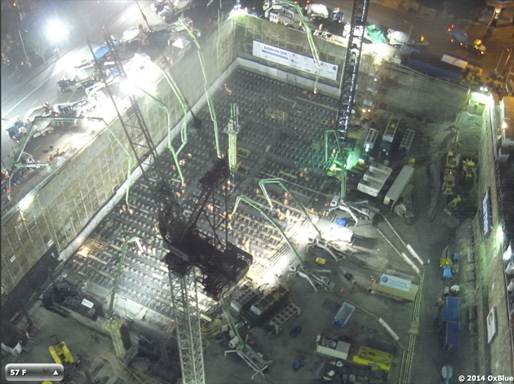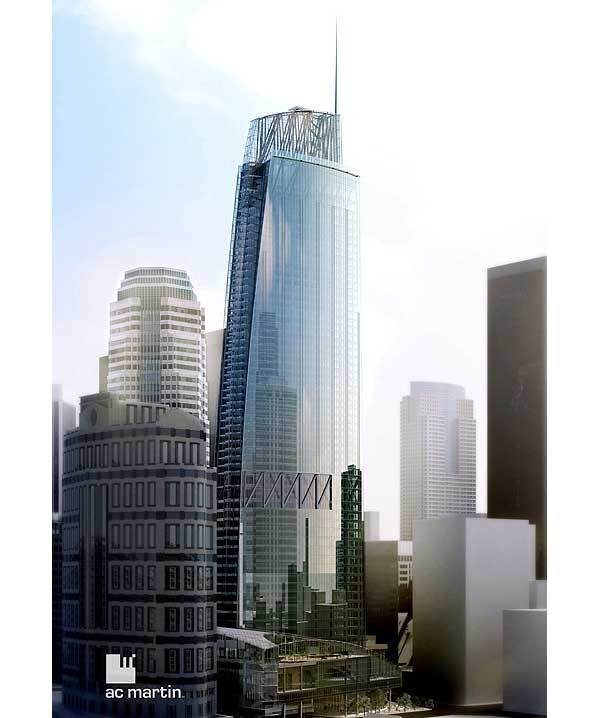After about 20 hours of continuous pouring, judges from Guinness World Records verified that the concrete pour at the $1 billion Wilshire Grand project in Los Angeles is the largest uninterrupted pour of slurry on record.
It took 208 trucks making as many as 10 deliveries each last weekend to complete the pour. In all, 21,000 cubic yards of concrete were poured to form the foundation for the 73-story tower.
The project, led by Turner Construction for developer Korean Air, includes office space, restaurants, retail, and 900 luxury hotel rooms. Scheduled to open in 2016, the tower will be the tallest building west of Chicago. AC Martin Partners is designing the 1,100-foot-tall tower, with Thornton Tomasetti as structural engineer.
Here are some of the pour’s impressive numbers:
• 19 pumps dispensed concrete into the pit through 13 hoses
• 24 temperature sensors provided hourly readings (the concrete should remain between 120 and 160 degrees)
• 45 degree water pumped through 100,000 feet of polyethylene hose snaked throughout the pit will help counteract the natural heating
• The concrete weighs some 82 million pounds
12:00 noon PST February 15, 2014
12:00 midnight PST February 15, 2014
Related Stories
| Oct 4, 2011
GREENBUILD 2011: Wall protection line now eligible to contribute to LEED Pilot Credit 43
The Cradle-to-Cradle Certified Wall Protection Line offers an additional option for customers to achieve LEED project certification.
| Oct 3, 2011
Magellan Development Group opens Village Market in Chicago’s Lakeshore East neighborhood
Magellan Development Group and Hanwha Engineering & Construction are joint-venture development partners on the project. The Village Market was designed for Silver LEED certification by Loewenberg Architects and built by McHugh Construction.
| Oct 3, 2011
Balance bunker and Phase III projects breaks ground at Mitsubishi Plant in Georgia
The facility, a modification of similar facilities used by Mitsubishi Heavy Industries, Inc. (MHI) in Japan, was designed by a joint design team of engineers and architects from The Austin Company of Cleveland, Ohio, MPSA and MHI.
| Oct 3, 2011
Cauceglia to lead Allsteel’s global accounts
Cauceglia is responsible for developing new global business strategies and expanding existing business within the Fortune 500 sector.
| Sep 30, 2011
BBS Architects & Engineers completes welcoming center at St. Charles Resurrection Cemetery
The new structure serves as the cemetery's focal architectural point and center of operations.
| Sep 30, 2011
Kilbourn joins Perkins Eastman
Kilbourn joins with more than 28 years of design and planning experience for communities, buildings, and interiors in hospitality, retail/mixed-use, corporate office, and healthcare.
| Sep 30, 2011
Design your own floor program
Program allows users to choose from a variety of flooring and line accent colors to create unique floor designs to complement any athletic facility.
| Sep 30, 2011
AAMA offers electronic technical documents with launch of virtual library
This new program offers a system for members to purchase annual licenses in order to offer electronic versions of AAMA publications in an effort to make AAMA’s technical information resources more readily available to their employees.
| Sep 29, 2011
Submit your Great Solutions
Profiles of Great Solutions will appear in December 2011 issue of Building Design+Construction.
| Sep 29, 2011
Busch Engineering, Science and Technology Residence Hall opens to Rutgers students
With a total development cost of $57 million, B.E.S.T. is the first on-campus residence hall constructed by Rutgers since 1994.




















